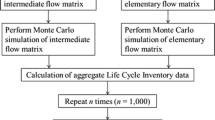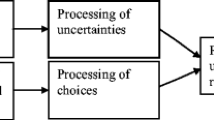Abstract
Purpose
Data used in life cycle inventories are uncertain (Ciroth et al. Int J Life Cycle Assess 9(4):216–226, 2004). The ecoinvent LCI database considers uncertainty on exchange values. The default approach applied to quantify uncertainty in ecoinvent is a semi-quantitative approach based on the use of a pedigree matrix; it considers two types of uncertainties: the basic uncertainty (the epistemic error) and the additional uncertainty (the uncertainty due to using imperfect data). This approach as implemented in ecoinvent v2 has several weaknesses or limitations, one being that uncertainty is always considered as following a lognormal distribution. The aim of this paper is to show how ecoinvent v3 will apply this approach to all types of distributions allowed by the ecoSpold v2 data format.
Methods
A new methodology was developed to apply the semi-quantitative approach to distributions other than the lognormal. This methodology and the consequent formulas were based on (1) how the basic and the additional uncertainties are combined for the lognormal distribution and on (2) the links between the lognormal and the normal distributions. These two points are summarized in four principles. In order to test the robustness of the proposed approach, the resulting parameters for all probability density functions (PDFs) are tested with those obtained through a Monte Carlo simulation. This comparison will validate the proposed approach.
Results and discussion
In order to combine the basic and the additional uncertainties for the considered distributions, the coefficient of variation (CV) is used as a relative measure of dispersion. Formulas to express the definition parameters for each distribution modeling a flow with its total uncertainty are given. The obtained results are illustrated with default values; they agree with the results obtained through the Monte Carlo simulation. Some limitations of the proposed approach are cited.
Conclusions
Providing formulas to apply the semi-quantitative pedigree approach to distributions other than the lognormal will allow the life cycle assessment (LCA) practitioner to select the appropriate distribution to model a datum with its total uncertainty. These data variability definition technique can be applied on all flow exchanges and also on parameters which play an important role in ecoinvent v3.

Similar content being viewed by others
References
Björklund A (2002) Survey of approaches to improve reliability in LCA. Int J Life Cycle Assess 7(2):64–72
Ciroth A, Fleischer G, Steinbach J (2004) Uncertainty calculation in life cycle assessments. Int J Life Cycle Assess 9(4):216–226
Ciroth A, Muller S, Weidema B, Leasge P (2013) Empirically based uncertainty factors for the pedigree matrix in ecoinvent. Int J Life Cycle Assess. doi:10.1007/s11367-013-0670-5
Coulon R, Camobreco V, Teulon H, Besnainou J (1997) Data quality and uncertainty in LCI. Int J Life Cycle Assess 2(3):178–182
Frischknecht R, Jungbluth N, Althaus H-J, Doka G, Dones R, Heck T, Hellweg S, Hischier R, Nemecek T, Rebitzer G, Spielmann M (2005) The ecoinvent database: overview and methodological framework. Int J Life Cycle Assess 10(1):3–9
Funtowicz SO, Ravetz JR (1990) Uncertainty and quality in science for policy. Philosophy and methodology of the social sciences. Kluwer Academic Publishers, Dordrecht
Hong J, Shaked S, Rosenbaum R, Jolliet O (2010) Analytical uncertainty propagation in life cycle inventory and impact assessment: application to an automobile front panel. Int J Life Cycle Assess 15(5):499–510
Huijbregts M (1998) Application of uncertainty and variability in LCA. Int J Life Cycle Assess 3(5):273–280
Huijbregts M, Norris G, Bretz R, Ciroth A, Maurice B, von Bahr B, Weidema B, de Beaufort A (2001) Framework for modelling data uncertainty in life cycle inventories. Int J Life Cycle Assess 6(3):127–132
Huijbregts MAJ, Gilijamse W, Ragas AMJ, Reijnders L (2003) Evaluating uncertainty in environmental life-cycle assessment. A case study comparing two insulation options for a Dutch one-family dwelling. Environ Sci Technol 37(11):2600–2608
Kennedy D, Montgomery D, Quay B (1996) Data quality: Stochastic environmental life cycle assessment modeling. Int J Life Cycle Assess 1(4):199–207
Limpert E, Stahel WA, Abbt M (2001) Log-normal distributions across the science: keys and clues. Biosc 51(5):341–351
Lloyd SM, Ries R (2007) Characterizing, propagating, and analyzing uncertainty in life-cycle assessment: a survey of quantitative approaches. J Ind Ecol 11(1):161–179
MacLeod M, Fraser AJ, Mackay D (2002) Evaluating and expressing the propagation of uncertainty in chemical fate and bioaccumulation models. Environ Toxicl Chem 21(4):700–709
Maurice B, Frischknecht R, Coelho-Schwirtz V, Hungerbühler K (2000) Uncertainty analysis in life cycle inventory. Application to the production of electricity with French coal power plants. J Clean Prod 8(2):95–108
ORACLE (2010) Oracle crystal ball for enterprise performance management. Fusion Edition Release 11(1):2.0.00
Rousseaux P, Labouze E, Suh Y, Blanc I, Gaveglia V, Navarro A (2001) An overall assessment of life cycle inventory quality. Int J Life Cycle Assess 6(5):299–306
Slob W (1994) Uncertainty analysis in multiplicative models. Risk Anal 14(4):571–576
Sonnemann GW, Schuhmacher M, Castells F (2003) Uncertainty assessment by a Monte Carlo simulation in a life cycle inventory of electricity produced by a waste incinerator. J Clean Prod 11(3):279–292
Tan RR, Culaba AB, Purvis MRI (2002) Application of possibility theory in the life-cycle inventory assessment of biofuels. Int J Energ Res 26(8):737–745
Vermeire TG, Stevenson H, Pieters MN, Rennen M, Slob W, Hakkert BC (1998) Assessment factors for human health risk assessment: a discussion paper. The Netherlands: National Institute of Public Health and the Environment (RIMVN) and Netherlands Organization for Applied Scientific Research
Weidema BP, Wesnæs MS (1996) Data quality management for life cycle inventories—an example of using data quality indicators. J Clean Prod 4(3–4):167–174
Weidema BP, Bauer C, Hischier R, Mutel C, Nemecek T, Reinhard J, Vadenbo CO, Wernet G (2013) Overview and methodology. Data quality guideline for the ecoinvent database version 3. Ecoinvent Report 1(v3). St. Gallen, The ecoinvent Centre
Acknowledgments
The authors would like to acknowledge the financial support of the industrial partners of the International Chair in Life Cycle Assessment and the International Life Cycle Chair (research units of CIRAIG): ArcelorMittal, Bell Canada, Bombardier, Cascades, Eco Entreprises Québec, Groupe EDF, GDF-SUEZ, Hydro-Québec, Johnson&Johnson, LVMH, Michelin, Mouvement Desjardins, Nestlé, Rio Tinto Alcan, RECYC-QUÉBEC, RONA, SAQ, Solvay, Total, Umicore, and Veolia Environnement. The industrial partners were in no way involved with the study design, the collection, analysis, and interpretation of the data, the writing of the paper, or the decision to submit the paper for publication.
The authors would also like to acknowledge the work of two anonymous reviewers that helped clarify and improve this paper.
Author information
Authors and Affiliations
Corresponding author
Additional information
Responsible editor: Reinout Heijungs
Electronic supplementary material
Below is the link to the electronic supplementary material.
ESM 1
(DOCX 17 kb)
Rights and permissions
About this article
Cite this article
Muller, S., Lesage, P., Ciroth, A. et al. The application of the pedigree approach to the distributions foreseen in ecoinvent v3. Int J Life Cycle Assess 21, 1327–1337 (2016). https://doi.org/10.1007/s11367-014-0759-5
Received:
Accepted:
Published:
Issue Date:
DOI: https://doi.org/10.1007/s11367-014-0759-5




